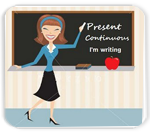Login form
Unit 22 Dialogues - Present Continuous
 1.What are you doing?
1.What are you doing?
I'm studying English. What are you doing?
I'm making some food. Do you want some?
Sure!
-----
2.
Right now I'm working at home. My friend is talking on the 'phone and my sister is studying Spanish. She wants to be a businesswoman, so she's learning a new language. I usually work at the office, but today I'm working at home. It's great fun!
-----
3.
How's Sarah?
She's fine. She's living in Chicago now.
Really!
Yes, and she's working as a fashion designer.
That's great. Is she having a good time?
Yes, she's doing really well.
--------
Key Vocabulary
|
make |
language |
Grammar
1. Present Continuous
The Present Continuous is used for actions that are happening around the present time. For example, "I am studying English" means that I am in the process of studying English now.
Form
The Present Continuous is formed by adding the verb "to be" and the -ing form
|
Singular Affirmative
I am studying Negative
I am not studying Questions
Do I have a pen? |
Plural Affirmative
We are studying Negative
We do not have a pen = We don't have a pen Questions
Do we have a pen?
|
For negatives we simply add not after the auxilary verb "to be", for example:
- I am playing - I am not playing.
For questions we invert the subject and auxiliary verb to be, for example:
- You are playing - Are you playing?
Usage
The Present Continuous is used for actions happening at the present time. For example:
- We are studying English.
- You are using a computer.
The Present Continuous is also used for processes happening around the present time. For example:
- It is raining today.
- I am working in Paris this month.
- The world is turning.
The time period of the first sentence is today, the second sentence one month, and the third sentence forever, but all of these sentences are about processes that happen around the present. They started before the present, are happening now, and will continue after the present. This is a key idea of the Present Continuous.
The Present Continuous is also used for repeated actions or habits. Such repetition is seen as one continuing process. For example:
- I am getting up early this week.
Obviously I'm not getting up just one time for a whole week, but during one week I will get up early every day, so this can be seen as one process.
The Present Continuous is also used for future arrangements at a particular time. For example:
- I'm going to Rome at 10.30 tomorrow.
- She's coming to my apartment this evening.
Spelling
To make the -ing form, also known as the present participle, we usually add -ing to the verb. For example:
- study - studying
- eat - eating
- jump - jumping
For verbs ending in -e, we leave out the -e and add -ing. For example:
- write - writing: not writeing
- skat - skating: not skateing.
For verbs ending in a vowel and a consonant, we usually double the last consonant and add -ing. For example:
- run - running: not runing
- cut - cutting: not cuting
For verbs ending in -ie we change the -ie to -y and add -ing. For example:
- lie - lying: not lieing
-----

